Armed with a washing up bowl and kids fishing net, two of my boys decided to go pond dipping. We stuck gold, smooth newts and stickleback fish.
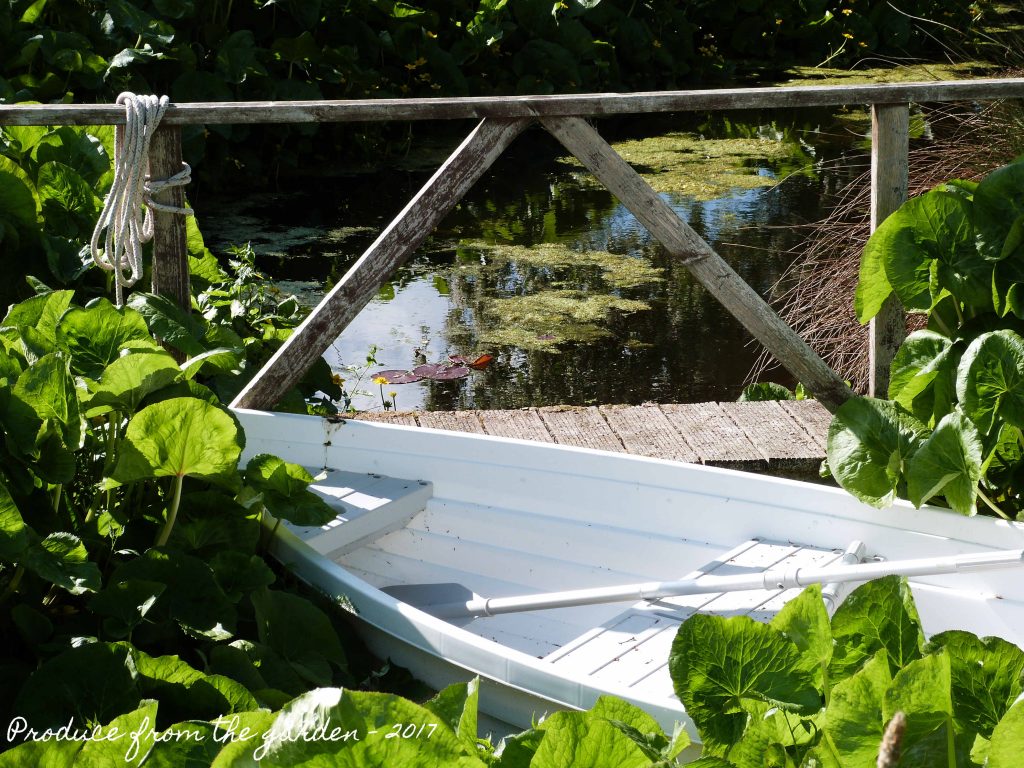 The pond dipping spot at the bottom of our garden
The pond dipping spot at the bottom of our garden
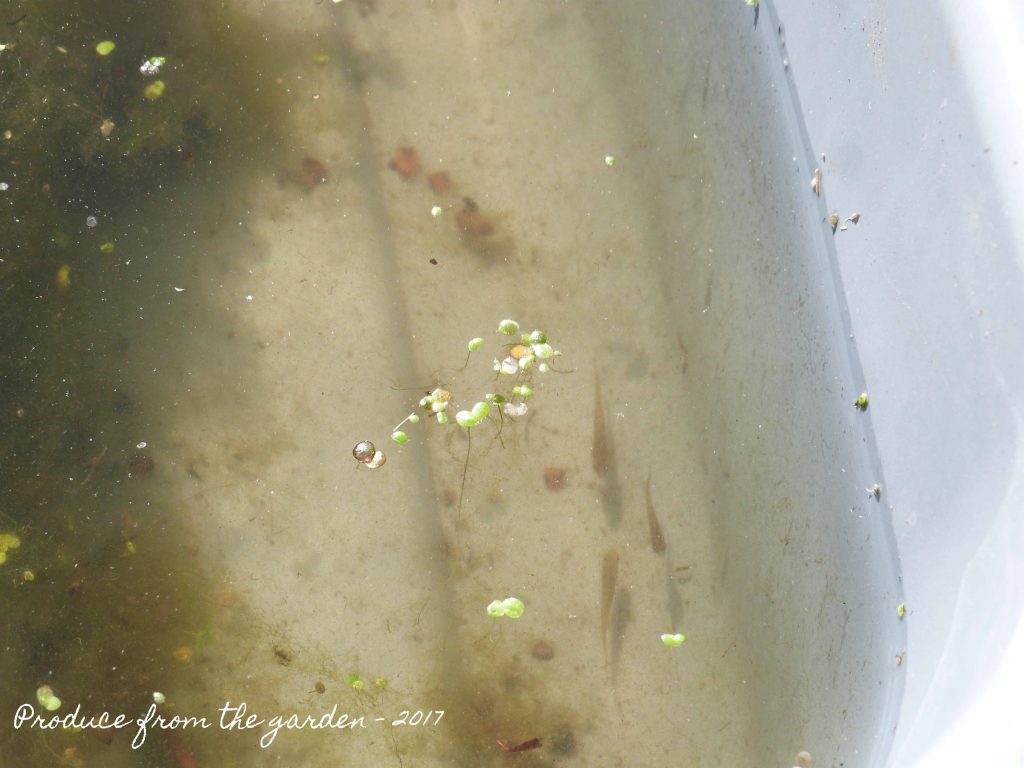 A terible picture of three of the fish the boys caught!
A terible picture of three of the fish the boys caught!
There are two ways to create a wild flower meadow, one which will take some time, effort and money, the other is quick, easy and cheap. Bet you can guess which option I took!
If you want perfect swaths of meadow flowers reminiscent of the amazing wildflower landscaping around the London Olympic park in 2012, I recommend the first option; stripping turf, rotavating, sowing special seed mixes and ta-da, you’ll be rewarded with a fabulous meadow; well in the first year, you might be a bit disappointed in the second, still a great meadow but it won’t self sow quite as prolifically as previously.
If you’re just after an area of garden that looks naturalistic with a few wild flowers and is a haven for wildlife, save yourself some time and money and go with my favoured second option.
For most wild meadow flowers to thrive the soil needs to be poor in nutrients, so a well tended, manure enriched part of the garden is not going to work that well, if this is what you’ve got, go for poppies and a cut flower annual mix which will give you a pretty garden meadow effect.
The perfect spots are often already grassed, in the past I created a lovely meadow in a mini orchard at our old house. Now I want to recreate the effect along the banks of our ditch and pond. This is an area we leave to its own devices, just regularly mowing a path and strimming the longer grass once a year in August. It’s already a haven for wildlife but we’d like to attract more and add some colour to enhance the walk around the pond.
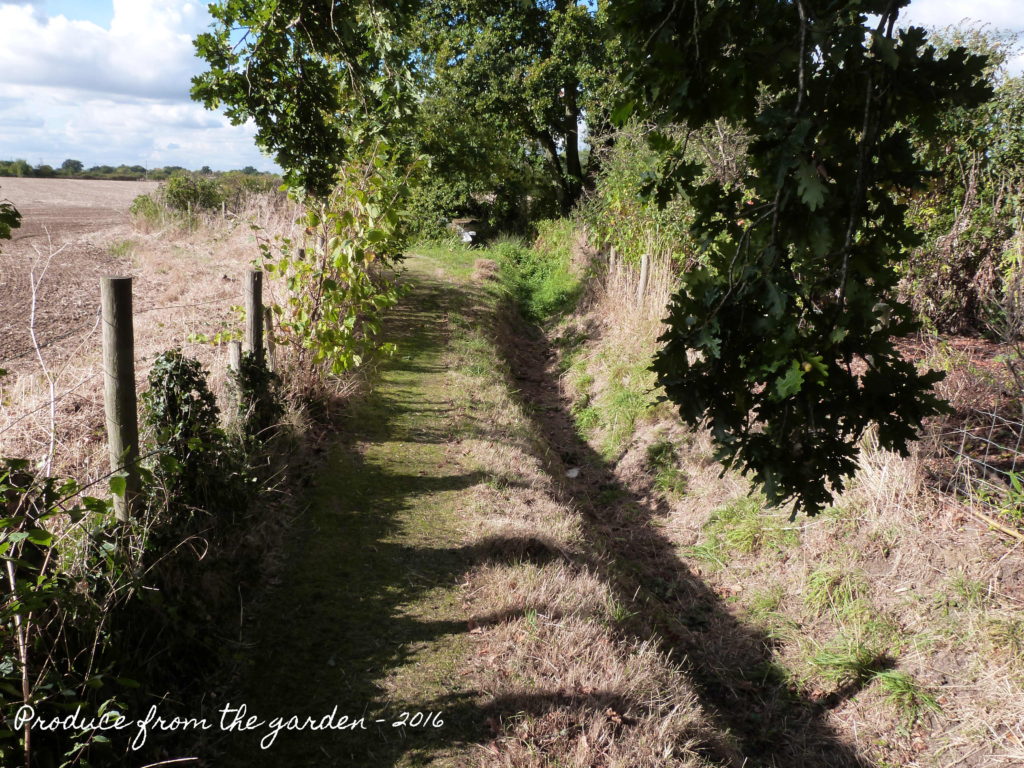 I plan to have a wild flower strip along the side of the ditch, in the rough grass to right of the path
I plan to have a wild flower strip along the side of the ditch, in the rough grass to right of the path
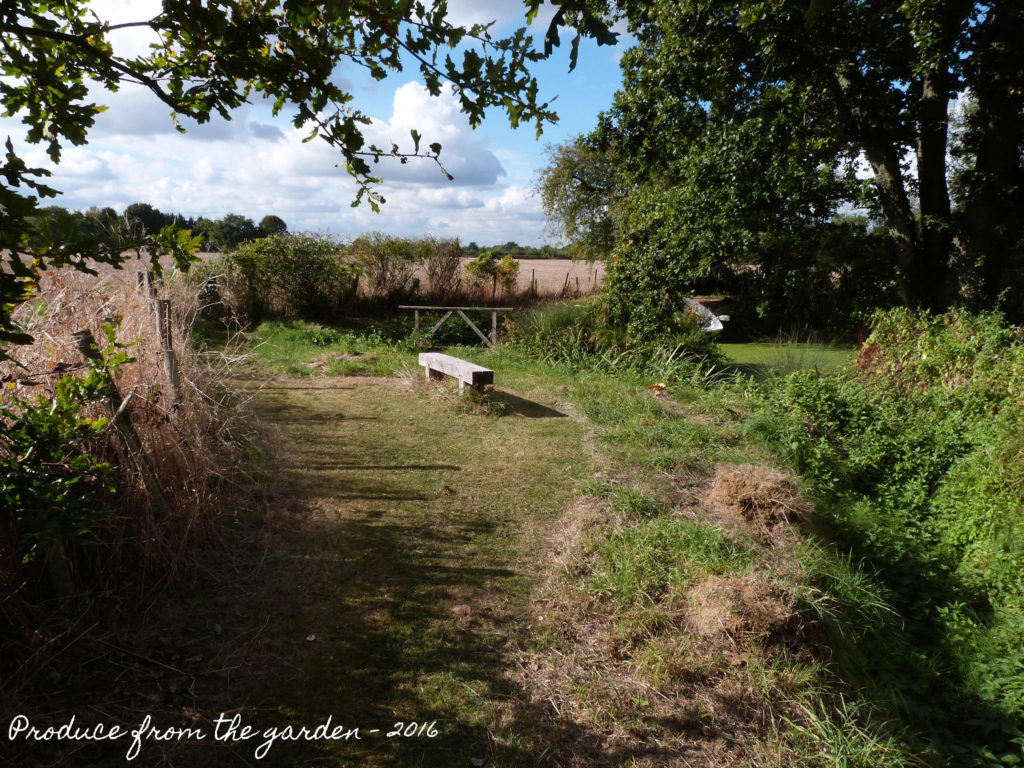 The wild flower strip will extend along the ditch, around the pond where you can see the rough grass
The wild flower strip will extend along the ditch, around the pond where you can see the rough grass
To give wild flowers the chance to thrive they need a bit of space, lush thick grass is going to smother any self respecting wild flower when it attempts to set seed. A clever solution to this problem is to grow Yellow Rattle, this pretty yellow flower is parasitic on grass roots extracting water and minerals. In the past it was hated by farmers as Yellow Rattle can reduce a hay crop by 50%. This is just what we’re after. If the Yellow Rattle does start to take over, deterring wild flowers you can just cut it back before it sets seed one year. The trick is to sow Yellow Rattle seed now in Autumn as it needs a long period of chill to enable germination in Spring. The easiest way to sow Yellow Rattle is by scrapping away a small patch of grass, digging the soil so it’s not too compact, watering and then sprinkling a few seeds. Repeat this every few feet in the area you want to establish a meadow.
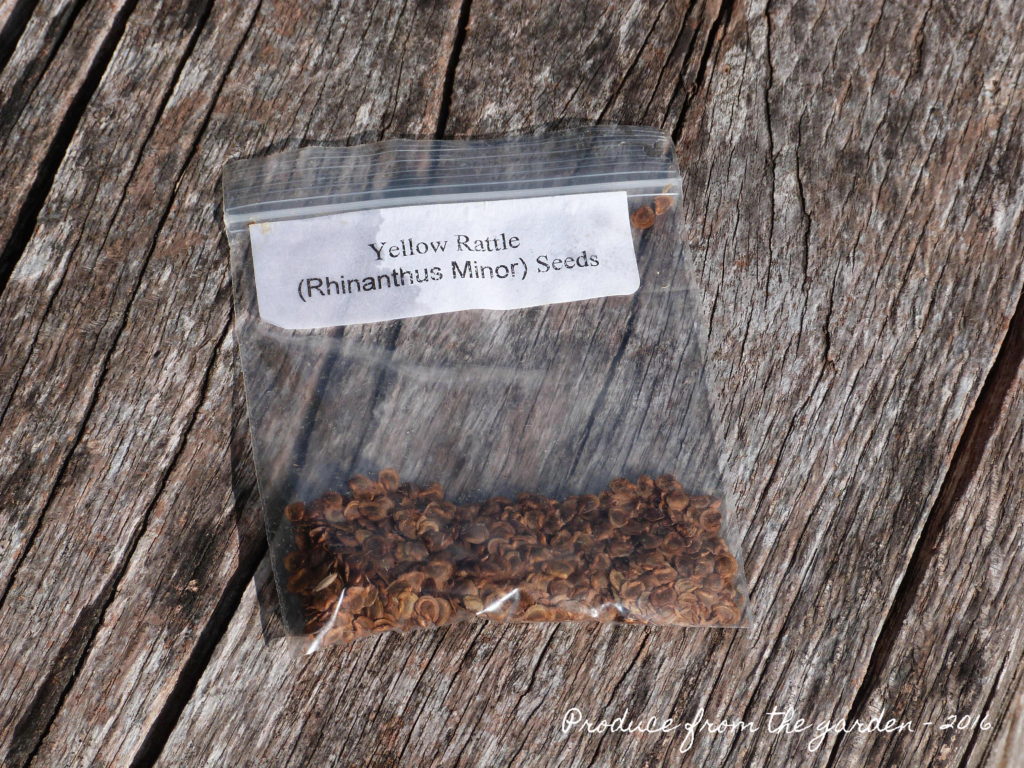 A packet of 600 Yellow Rattle seeds for £1.80
A packet of 600 Yellow Rattle seeds for £1.80
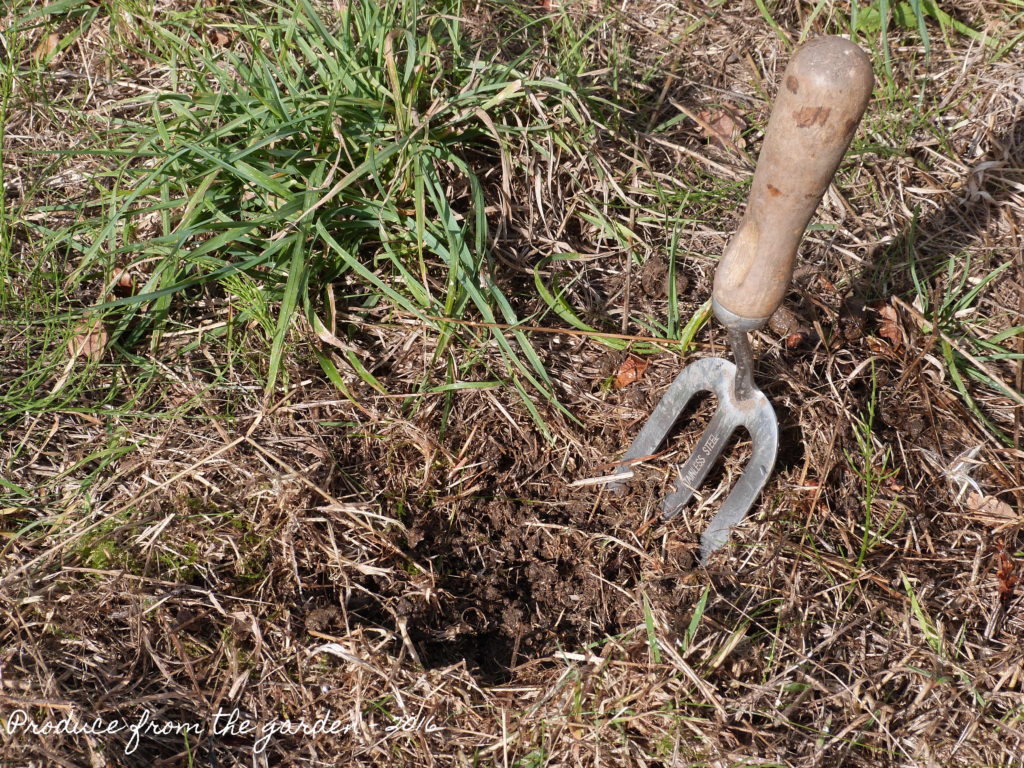 One of the little patches ready for Yellow Rattle to be sown in
One of the little patches ready for Yellow Rattle to be sown in
I then wait till spring to sow wild flower seed into pots with low nutrient seed compost. Once established in early May, I then pot out into the meadow area, allowing them to thrive and set seed starting the annual cycle of a wild flower meadow.
After the meadow is planted there is just one rule. Cut the meadow once a year in late July/ August, after flowering, leave the ‘hay’ to dry, allowing seed to disperse and set for next year. After a week or so remove the hay as you don’t want it to rot down into the soil adding nutrients.
I look forward to posting some blooming meadow pictures early next summer.
Below are some suggested wild flowers for different sites:
Woodland / shaded area
Wood Sage
Hedge Garlic
Hedge Woundwort
Herb Bennet
Nettle Leaved Bell Flower
Ragged Robin
Red Campion
Self Heal
Square St Johns Wort
Sweet Cicely
Upright Hedge Parsley
Wild Angelica
Wild fox glove
Wood Sage
Clay soils in an open aspect
Autumn Hawkbit
Betony
Birdsfoot Trefoil
Corn Poppy
Cowslip
Goatsbeard
Lady’s Bedstraw
Lesser Knapweed
Meadow Buttercup
Meadow Vetchling
Musk Mallow
Ox Eye Daisy
Ragged Robin
Ribwort Plantain
Self Heal
Common Sorrel
White Campion
Wild Carrot
Yarrow
Yellow Rattle
Wild Clary
Sandy soils in an open aspect
Agrimony
Meadow Cranesbill
Birdsfoot Trefoil
Corn Poppy
Dark Mullein
Kidney Vetch
Lady’s Bedstraw
Meadow Buttercup
Musk Mallow
Ox Eye Daisy
Ribwort Plantain
Self Heal
Sorrel
White Campion
Wild Carrot
Yarrow
Yellow rattle
Chalk Soils in an open aspect
Birdsfoot Trefoil
Common Vetch
Corn Poppy
Cowslip
Dropwort
Kidney Vetch
Lady’s Bedstraw
Meadow Buttercup
Meadow Cranesbill
Musk Mallow
Ox Eye Daisy
Rough Hawkbit
Ribwort Plantain
Salad Burnet
Self Heal
Common Sorrel
Small Scabious
Wild Carrot
Wild Marjoram
We’ve just been visited by a Kestrel who sat on our telegraph wire, starred me out, then moved onto the TV areal, and then off. I’ve not noticed a Kestrel visit before. I often hear the loud call of hunting buzzards high above in groups but until now we’ve not seen a Kestrel.
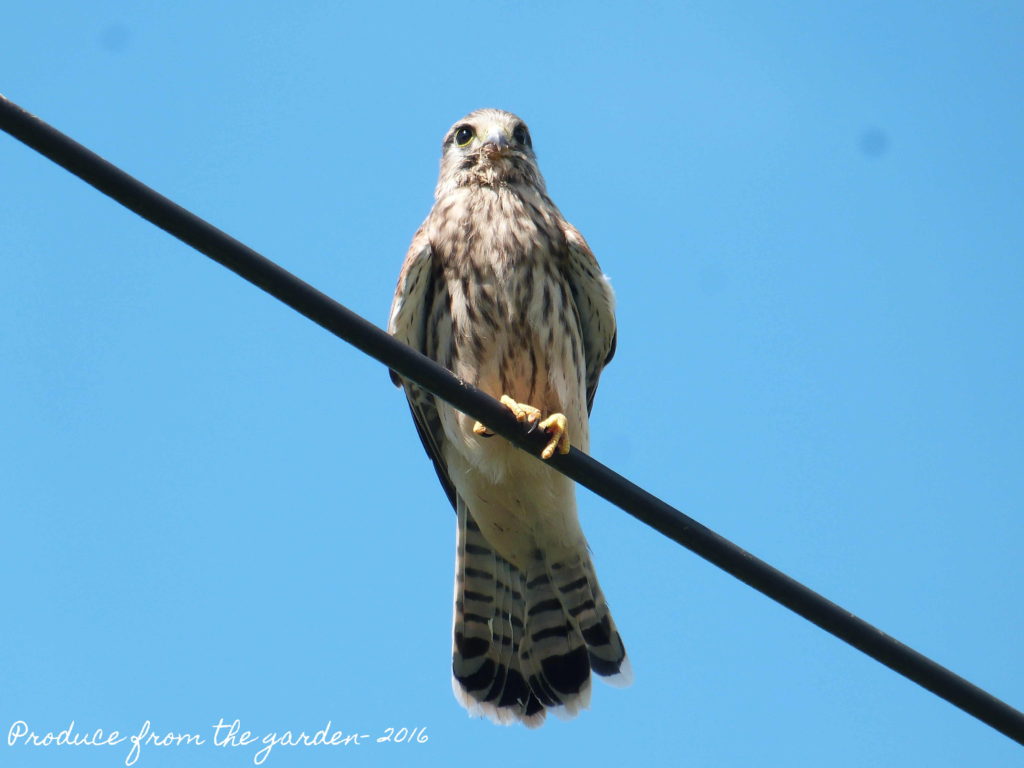 The Kestrel on our telegraph wire
The Kestrel on our telegraph wire
Sadly our beloved dog Rolo died last month, this and the demands of the garden in April has meant I’ve not been out walking. So a walk this morning with a friend and her gorgeous retriever was a wonderful treat. Below is a flavour of our lovely morning stroll along a river and through woods and meadows.
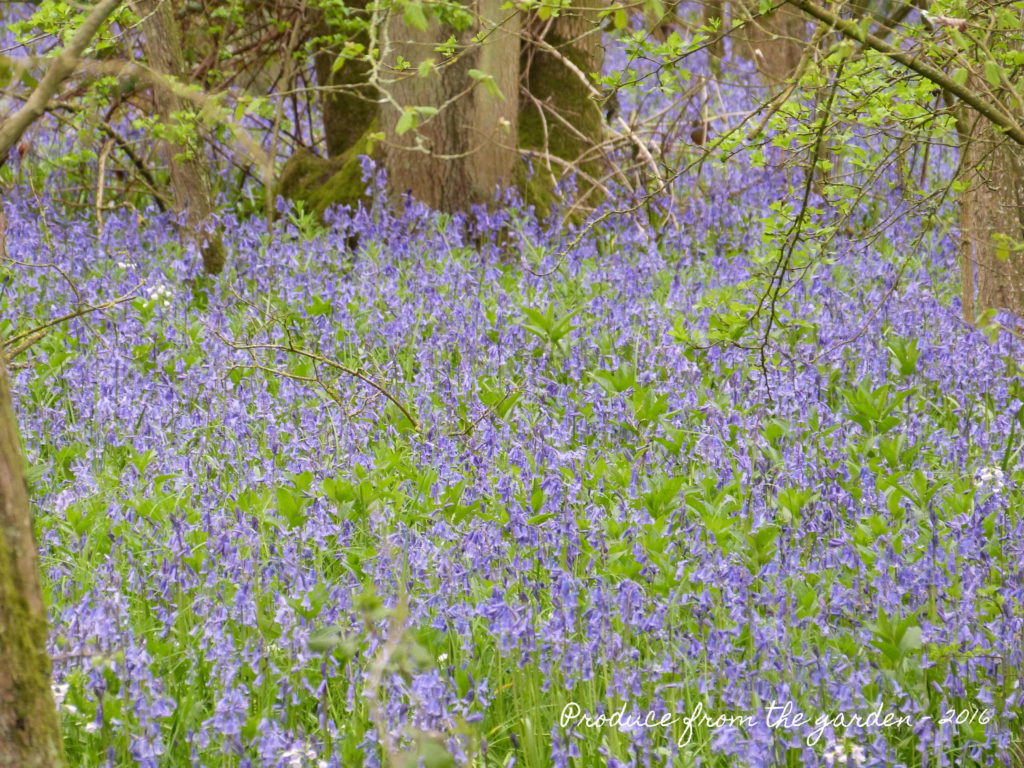 I might be biased but, Kent has the most beautiful bluebell woods in the world. The intense blue that radiates from the woodland floor stops me in my tracks. Sadly I’ve been unable to represent the intensity of colour in my pictures.
I might be biased but, Kent has the most beautiful bluebell woods in the world. The intense blue that radiates from the woodland floor stops me in my tracks. Sadly I’ve been unable to represent the intensity of colour in my pictures.
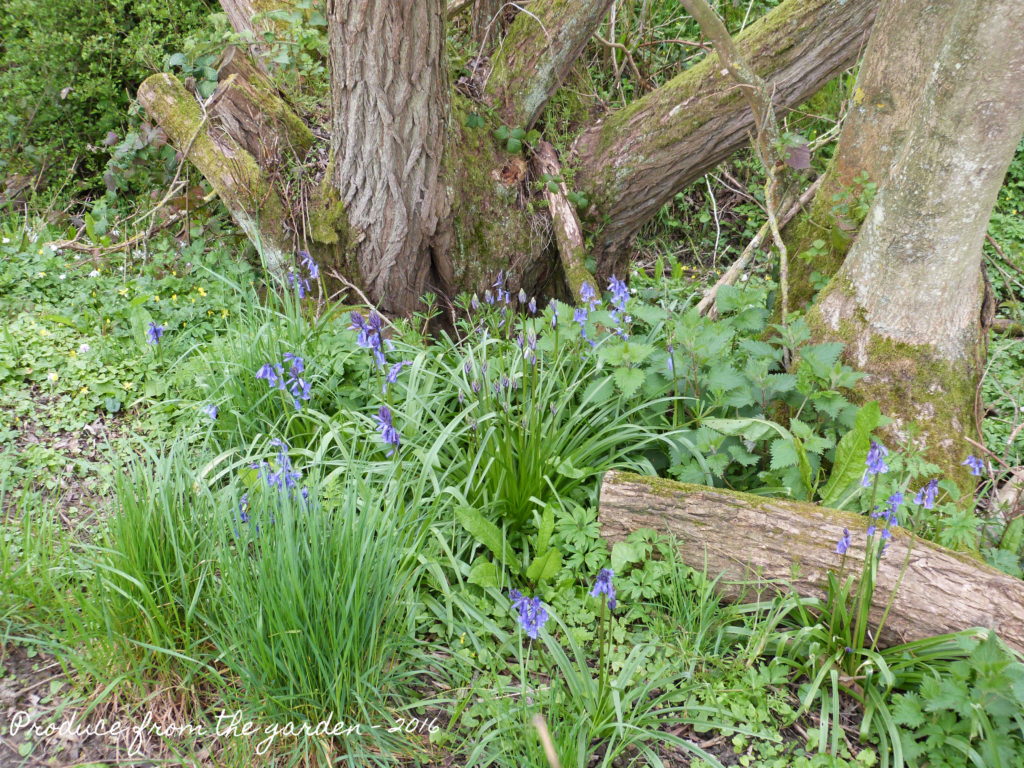 Bluebells on the edge of woodland
Bluebells on the edge of woodland
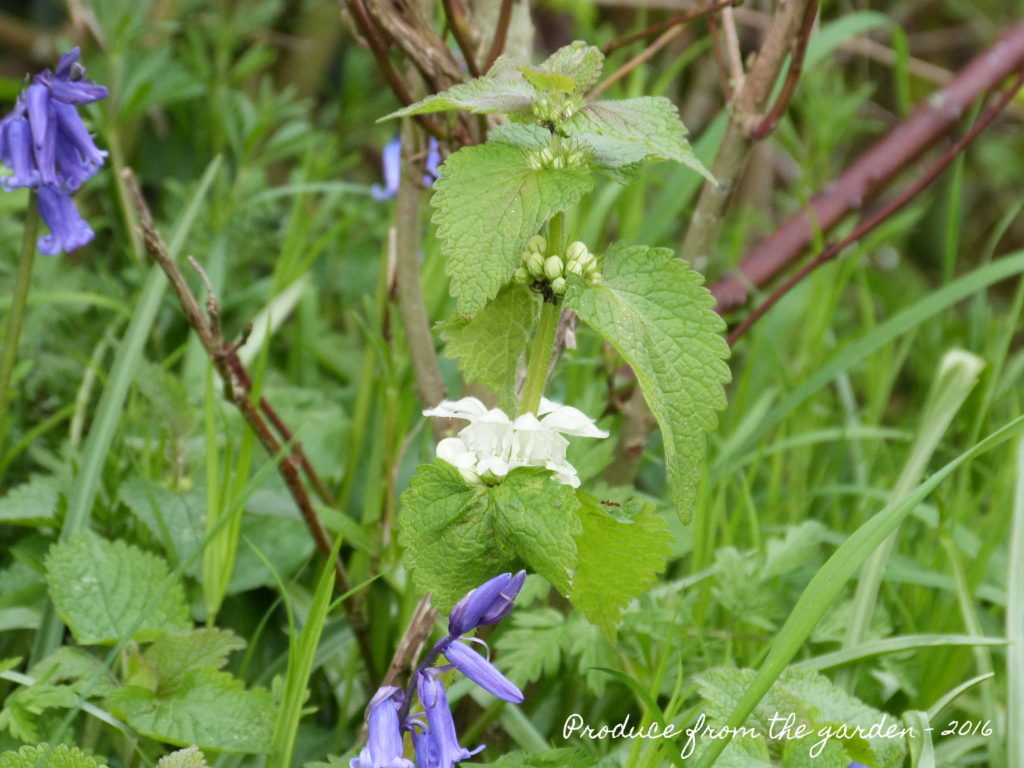 Lamium album (White Dead Nettle)
Lamium album (White Dead Nettle)
I am thrilled to announce that Elizabeth (Mrs Duck) has twelve incredibly cute ducklings. I’d not seen her for a while and spotted her on our pond this morning with her new brood. All my gardening jobs have gone out the window and I’m now in the process of blocking up all the fox runs with hope that Mr Fox doesn’t discover the new family.
Our wild ducks are back on the pond. They leave us in autumn for a preferred winter spot. Wherever this desirable location is, it’s tamed them this year; they seem oblivious to my boys, their friends and the dogs attention. My boys have even named them, Shaun and Elizabeth, not traditional duck names, but what can you expect from a family whose cat is called Mao! Fingers crossed for ducklings, we did see eggs last year but we think the fox who considers our garden its home got them. Operation duck watch is sadly a step too far so I fear the same again this year.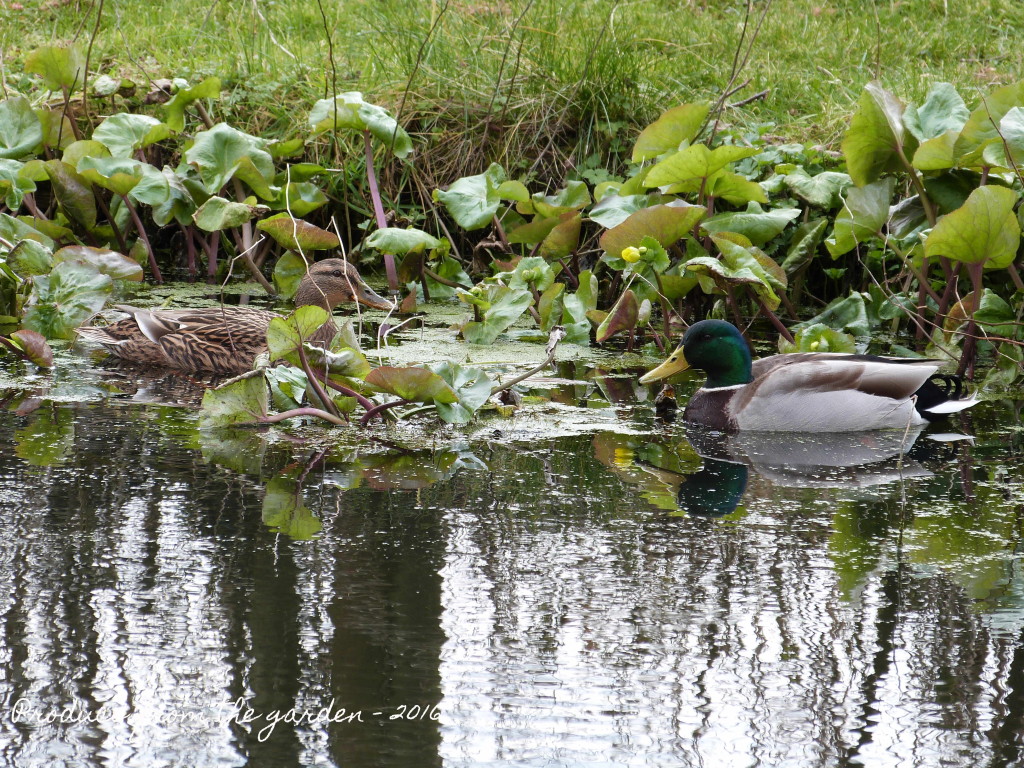
A friend passed on a Facebook challenge to post a nature photograph every day for a week. It has been great fun and a lovely snap shot of a week in February. Below is the compilation of the weeks posts.
Day 1 Hardy Cyclamen leaves growing under a tree in our garden, I think the leaves are more striking than their beautiful flowers.
Day 2 Lichen growing on our Crabapple tree. I love the rich mustard yellow colour of lichen.
Day 3 Broad bean flowers in February, I find that as disturbing as daffodils blooming in December!
Day 4 Artichoke leaves. Young silver leaves with the texture of velvet, an opulent, statuesque must have for every garden. The globes they produce are a summer delicacy, the leaves look fabulous cut and placed in a vase in the kitchen.
Day 5 Our oak tree on this frosty morning. This beautiful majestic oak is the focal point of our garden, it’s the home to many birds, my barometer of the seasons and it’s bows the anchor for my boys treasured rope swing.
Day 6 Muscari (Grape hyacinth). One of my favourite early sping (!) cut flowers.
Day 7 Some daffodils cut for the table. They may be early this year but their stems are weak, breaking under the weight of their blooms in the rain.
January has been a quiet month for ‘Produce from the Garden’. All child free time has been dedicated to two causes, the first cutting back and clearing brambles, a job I’ve not enjoyed. The result, thorn splitters in my hands (despite good quality leather gloves) and I’ve gained an extra four metres of front garden. A friend did question the merits of my bramble quest suggesting that I’ve now got another 4 metres of garden to maintain and tend, obviously not a keen gardener, who can say no to a bit more space.
My second January cause has been building a guinea pig run for my middle son who’s getting guinea pigs for his birthday in early February. The project was driven by my shock at the cost of guinea pig runs in the shops and the need to go off the shelf to sandwich the run in winter months between my green house staging in the conservatory. As normal I started the project with zest and enthusiasm, unusually my passion waned after a week, by week three, I was ‘completely over guinea pigs’ and in awe of all carpenters skills. Finally the run is finished and waiting for its occupants to move in. I have just realised that guinea pigs are incompatible with the ‘Produce from the Garden’ ethos of garden productivity for the home, I consol myself with the thought that their poo must be beneficial for the compost heap!
Whatever the weather I’m back in the garden next week clearing old compost heaps, oh the joys of winter gardening, roll on spring.
On cue, following my moan about the mild weather, a cold spell has set in. Today, to my three boy’s excitement, we woke to a sprinkling of snow. By 7.30am they’d dressed, put on scarves, hats and gloves and were out in the dim early morning light making the most of what little snow there was. Sadly for them it only stayed a few hours. Hopefully we’ll get one proper day of snow this year. A day off school and 6 inches of snow are the makings of magical childhood memories we all cherish.
On a gardening note I’m keeping my fingers crossed that multiple frosts have put paid to the hungry caterpillars, slugs and white fly who’ve been languishing in my vegetable beds.
Two unusual sightings in the garden; a peacock butterfly, showing what a mild November we’re having and a very brave or stupid pheasant! Our perpetually hungry dog, Rolo, favourite gourmet snack is fresh pheasant, such delicacies are rare for him these days as he’s an old slow boy with little sight, however, a game bird taking a stroll in our garden is not going to stop him trying!
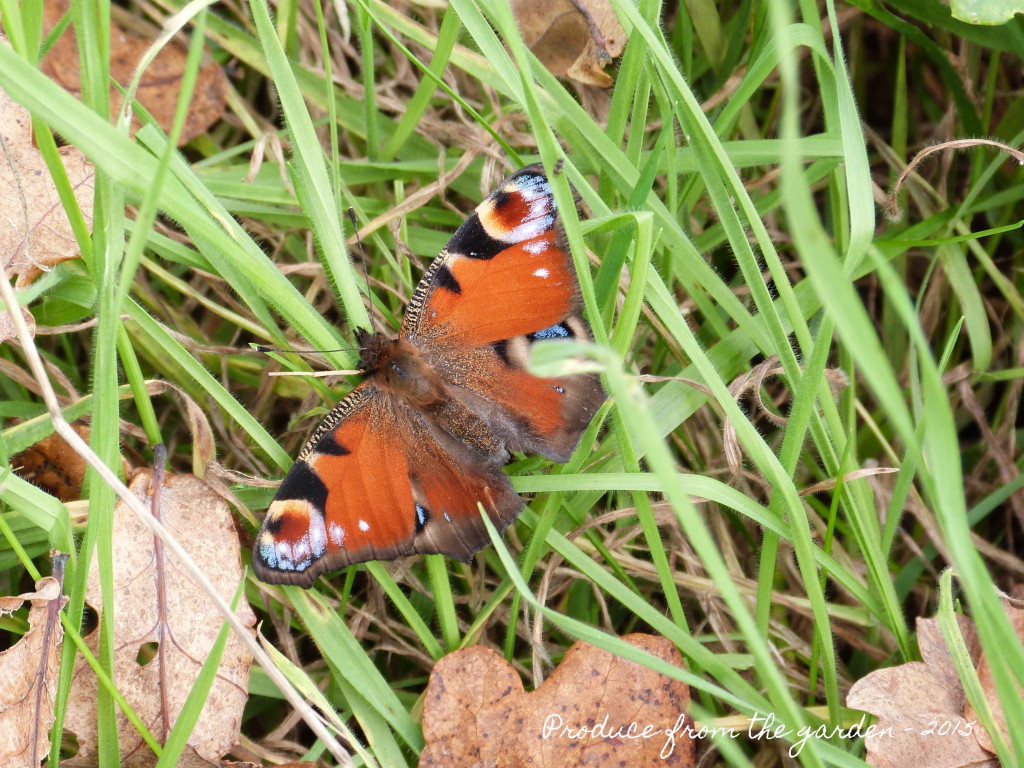 Peacock butterfly out in November
Peacock butterfly out in November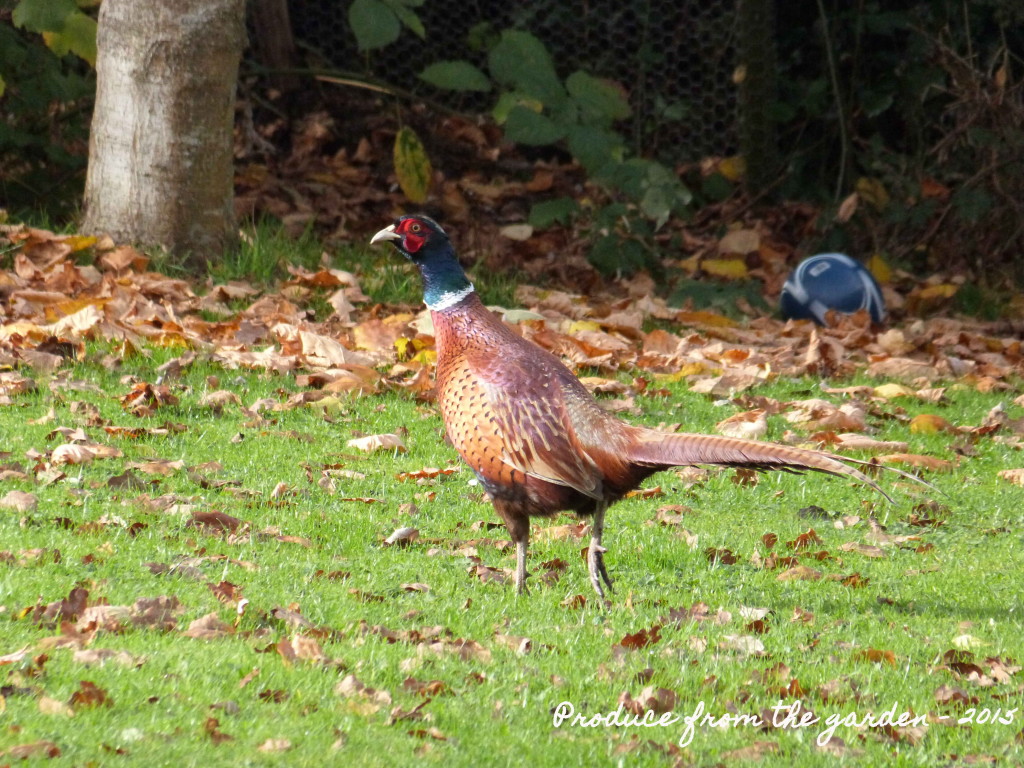 A pheasant taking a stroll in our garden
A pheasant taking a stroll in our garden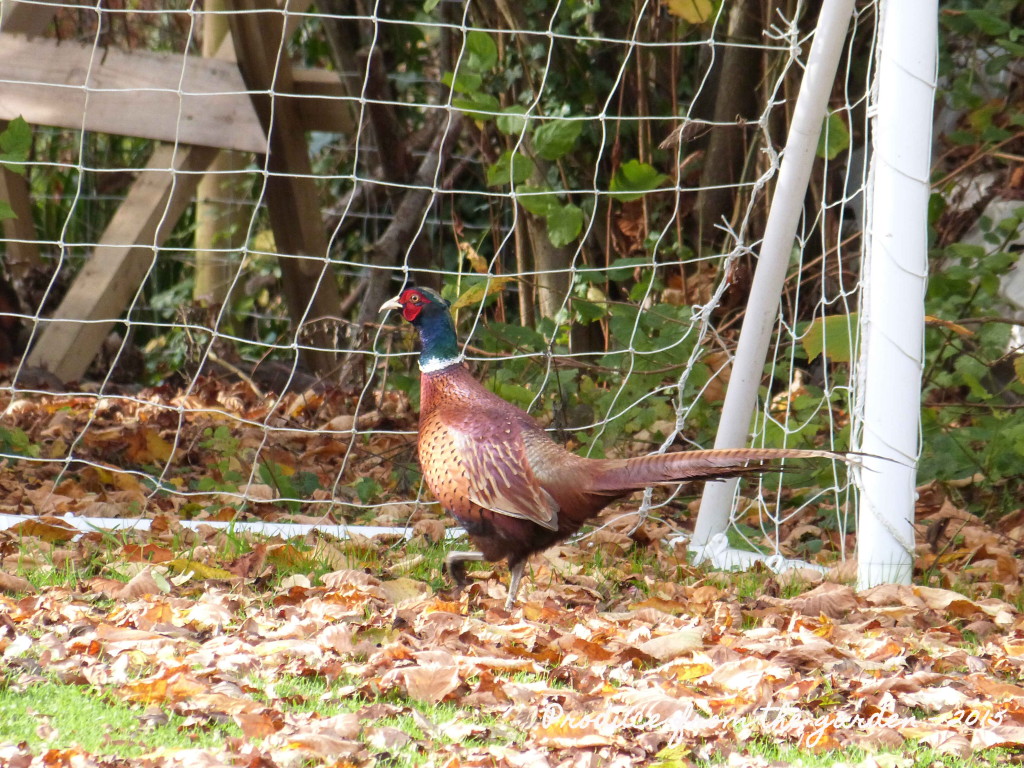 Pheasant in goal!
Pheasant in goal!